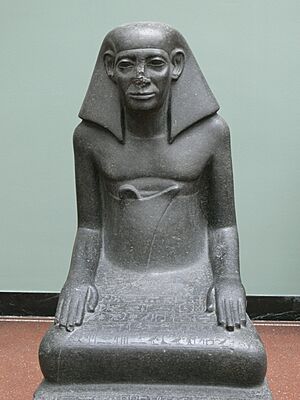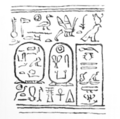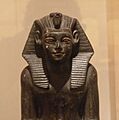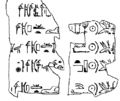Thirteenth Dynasty of Egypt facts for kids
Quick facts for kids
Thirteenth Dynasty of Egypt
|
|||||||||||||||
|---|---|---|---|---|---|---|---|---|---|---|---|---|---|---|---|
| 1803 BC–1649 BC | |||||||||||||||
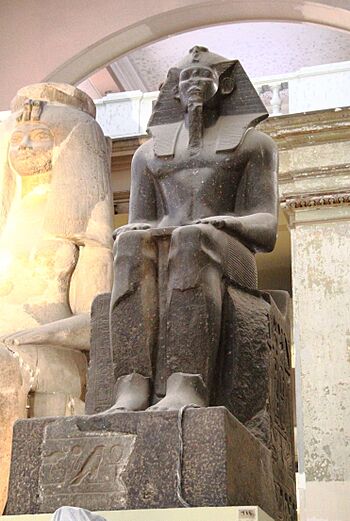
Granite statue of Pharaoh Imyremeshaw in the Egyptian Museum in Cairo
|
|||||||||||||||
| Capital | Itjtawy (c. 1803 BC – c. 1677 BC) Thebes (c. 1677 BC – c. 1648 BC) |
||||||||||||||
| Common languages | Egyptian language | ||||||||||||||
| Religion | ancient Egyptian religion | ||||||||||||||
| Government | Absolute monarchy | ||||||||||||||
| Historical era | Second Intermediate Period of Egypt | ||||||||||||||
|
• Established
|
1803 BC | ||||||||||||||
|
• Disestablished
|
1649 BC | ||||||||||||||
|
|||||||||||||||
The Thirteenth Dynasty was a group of rulers in ancient Egypt. They ruled for about 154 years, from around 1803 BC to 1649 BC. This time is often seen as the end of Egypt's Middle Kingdom. However, some historians place it at the start of the Second Intermediate Period.
At first, the Thirteenth Dynasty controlled a large area. This stretched from the Nile Delta in the north to the second cataract of the Nile in the south. But over time, their power weakened. Other groups, like the Fourteenth Dynasty and the Hyksos, began to take control.
Historians usually consider Sekhemre Khutawy Sobekhotep to be the first pharaoh of this dynasty. Merneferre Ay was a very important pharaoh. He was the last one to rule from the main capital city of Itjtawy. He also had one of the longest reigns in the dynasty.
Contents
Who Ruled When?
Historian Kim S. B. Ryholt believes the Thirteenth Dynasty lasted from 1803 BC to 1649 BC.
The Thirteenth Dynasty had some connections to the earlier Twelfth Dynasty. For example, the first pharaoh, Sobekhotep I, was the son of someone named Amenemhat. Some think this Amenemhat might have been Amenemhat IV. However, this is unlikely because Amenemhat IV was followed by his sister, not directly by Sobekhotep I.
Ryholt also suggests that the Thirteenth Dynasty began when the 14th Dynasty became independent. This happened in the eastern Delta region. The pharaohs of the 13th Dynasty ruled from Memphis. Their control stretched over Middle and Upper Egypt.
Over 150 years, the power of the 13th Dynasty slowly faded. It ended when the 15th Dynasty (the Hyksos) took over Memphis around 1650 BC.
Some old texts describe this time as chaotic. But it might have been more peaceful than once thought. The central government in Itj-tawy stayed strong for most of the dynasty. The country remained fairly stable. Still, it was a time of decline. Many kings ruled for only short periods. We don't have many records or monuments from this time. Many kings' names are known only from small inscriptions or scarabs.
Important Pharaohs of the Thirteenth Dynasty
Here are some of the pharaohs who ruled during this time:
| Name of Pharaoh | Image | Dates | Burial Site | Queen(s) | Notes |
|---|---|---|---|---|---|
| Sekhemre Khutawy Sobekhotep I |  |
1803–1800 BC | Most historians agree he started the dynasty. | ||
| Sonbef |  |
1800–1796 BC | Possibly a son of Amenemhat IV. | ||
| Nerikare | 1796 BC | ||||
| Sekhemkare Amenemhat V |  |
1796–1793 BC | |||
| Ameny Qemau |  |
1795–1792 BC | Pyramid of Ameny Qemau | ||
| Hotepibre Qemau Siharnedjheritef |  |
1792–1790 BC | |||
| Iufni | 1790–1788 BC | Known only from the Turin King List. | |||
| Seankhibre Ameny-Intef-Amenemhat VI | 1788–1785 BC | ||||
| Semenkare Nebnuni | 1785–1783 BC or 1739 BC | ||||
| Sehetepibre Sewesekhtawy |  |
1783–1781 BC | |||
| Sewadjkare I | 1781 BCE | Known only from the Turin King List. | |||
| Nedjemibre | 7 months, 1780 BC or 1736 BC | Known only from the Turin King List. | |||
| Khaankhre Sobekhotep II |  |
1780–1777 BC | |||
| Renseneb Amenemhat | 1777 BC | ||||
| Awybre Hor |  |
1777–1775 BC | Buried in Dahshur near the pyramid of Amenemhet III | Nubhetepti (?) | |
| Sekhemrekhutawy Khabaw | 1775–1772 BC | Possibly a son of Hor Awybre. | |||
| Djedkheperew | 1772–1770 BC | Possibly a brother of Sekhemrekhutawy Khabaw. | |||
| Sebkay | Possibly two kings, Seb and his son Kay. | ||||
| Sedjefakare Kay-Amenemhat VII | 5 to 7 years or 3 years, 1769–1766 BC | ||||
| Khutawyre Wegaf | Around 1767 BC | ||||
| Userkare Khendjer |  |
Minimum 4 years and 3 months c. 1765 BC | Pyramid of Khendjer, South Saqqara | Seneb[henas?] | |
| Smenkhkare Imyremeshaw |  |
Reigned less than 10 years, starting 1759 BC or 1711 BC. | Aya (Iy)? | ||
| Sehetepkare Intef |  |
Less than 10 years | Aya (Iy)? | ||
| Seth Meribre |  |
Reign ended 1749 BCE | |||
| Sekhemresewadjtawy Sobekhotep III | 1755–1751 BC | Senebhenas Neni |
|||
| Khasekhemre Neferhotep I |  |
1751–1740 BC | Perhaps buried at Abydos: S 9 | Senebsen | |
| Menwadjre Sihathor | 1739 BC | Ruled briefly with his brother Neferhotep I. | |||
| Khaneferre Sobekhotep IV |  |
1740–1730 BC | Perhaps buried at Abydos: S 10 | Tjan | Brother of Neferhotep I and Sihathor. |
| Merhotepre Sobekhotep V |  |
c. 1730 BC | Nubkhaes ? | ||
| Khahotepre Sobekhotep VI |  |
Around 1725 BC | |||
| Wahibre Ibiau |  |
1725–1714 BC or 1712–1701 BC | |||
| Merneferre Ay | 23 years, 8 months and 18 days, 1701–1677 BC or 1714–1691 BC | Built a pyramid whose location is unknown, maybe near Memphis. | Inni ? | Ruled for 23 years, the longest reign of the dynasty. |
After these kings, the remaining rulers of the 13th Dynasty are mostly known from Upper Egypt. This might mean they moved their capital from Itjtawy to Thebes. Some historians think this move happened because invaders from Canaan took over the eastern Delta and Memphis. For some, this marks the end of the Middle Kingdom.
However, other historians disagree. They point to a stone carving (stele) of Seheqenre Sankhptahi. This pharaoh ruled near the end of the dynasty. The stele suggests he still ruled over Memphis.
| Image | Pharaoh | Notes |
|---|---|---|
| Merhotepre Ini | Also known as Ini I. | |
| Sankhenre Sewadjtu | ||
| Mersekhemre Ined | Possibly the same as Neferhotep II. | |
| Sewadjkare Hori | Also known as Hori II. | |
| Merkawre Sobekhotep VII | ||
|
|
||
| Merkheperre | ||
| Merkare | Known only from the Turin King List. | |
|
|
||
| Sewadjare Mentuhotep V | ||
| [...]mosre | ||
| Ibi [...]maatre | ||
| Hor [...] [...]webenre | ||
| Se[...]kare | ||
| Seheqenre Sankhptahi | Shown on a stele giving offerings to the god Ptah. | |
| [...]re | ||
| Se[...]enre |
Some rulers from this dynasty are known, but their exact place in the timeline is unclear.
| Image | Pharaoh | Notes |
|---|---|---|
| Mershepsesre Ini II | ||
| Mersekhemre Neferhotep II | Possibly the same as Mersekhemre Ined. | |
| Sewahenre Senebmiu | ||
| Sekhanenre ...re | ||
| Sobekhotep IX |
Sobekhotep I and II
Historian Ryholt suggests that "Sobkhotep I Sekhemre Khutawy" was the first king of this dynasty. This idea is now widely accepted. So, Sobekhotep Sekhemre Khutawy is called Sobekhotep I in this article. Ryholt believes Sobekhotep I ruled for 3 to 4 years around 1800 BC. He thinks Khaankhre Sobekhotep II ruled about 20 years later, around 1780 BC.
What Happened Next?
The Egyptian government stopped looking after its forts in the south. Soon, the powerful Kush (in what is now Nubia) took over these forts. In the north, a group called the Hyksos invaded Lower Egypt. They were a Semitic people from the Sinai region.
An independent group of kings formed the 14th Dynasty in the western Delta. This happened while the 13th Dynasty was still ruling. According to an ancient historian named Manetho, the Hyksos invaders then took over Egypt. He wrote that they did this "without striking a blow." They burned cities and destroyed temples. Their rule, called the 15th Dynasty, replaced the 13th and 14th Dynasties in most of the country.
However, new discoveries at Edfu suggest a different story. Archaeologists found seals of the Hyksos ruler Khyan alongside seals of the 13th Dynasty king Sobekhotep IV. This suggests that Sobekhotep IV and Khyan might have ruled at the same time. If true, it means the 13th Dynasty did not control all of Egypt when Sobekhotep IV was in power. It also means the Hyksos were already present in Egypt.
This could mean that Manetho's story of a sudden, violent takeover by the Hyksos might be exaggerated. Instead, the 13th Dynasty's power might have slowly fallen apart. The Hyksos then simply took over Memphis and ended the 13th Dynasty's kingdom. However, some historians disagree with this idea. They argue that pharaohs' seals were used long after their deaths. So, the seals of Sobekhotep IV might not mean he lived at the same time as Khyan.
Merneferre Ay was the last pharaoh of the 13th Dynasty who had control over both Lower and Upper Egypt. After him, later rulers like Merhotepre Ini are only known from Upper Egypt.
Images for kids








